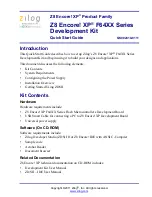MCF51CN128 Reference Manual, Rev. 6
Freescale Semiconductor
5-1
Chapter 5
Resets, Interrupts, and General System Control
5.1
Introduction
This section discusses basic reset and interrupt mechanisms and the various sources of reset and interrupt
on an MCF51CN128 series microcontroller. Some interrupt sources from peripheral modules are
discussed in greater detail within other sections of this document. This section gathers basic information
about all reset and interrupt sources in one place for easy reference. A few reset and interrupt sources,
including the computer operating properly (COP) watchdog are not part of on-chip peripheral systems with
their own chapters.
5.2
Features
Reset and interrupt features include:
•
Multiple sources of reset for flexible system configuration and reliable operation
•
System reset status (SRS) register to indicate source of most recent reset
•
Separate interrupt vector for most modules (reduces polling overhead) (see
5.3
Microcontroller Reset
Resetting the microcontroller provides a way to start processing from a known set of initial conditions.
When the ColdFire processor exits reset, it fetches initial 32-bit values for the supervisor stack pointer and
program counter from locations 0x(00)00_0000 and 0x(00)00_0004, respectively. On-chip peripheral
modules are disabled and I/O pins are initially configured as general-purpose high-impedance inputs with
pull-up devices disabled.
The MCF51CN128 series microcontrollers have the following sources for reset:
•
Power-on reset (POR)
•
External pin reset (PIN)
•
Computer operating properly (COP) timer
•
Illegal opcode detect (ILOP)
•
Illegal address detect (ILAD)
•
Low-voltage detect (LVD)
•
Clock generator (MCG) loss of clock reset (LOC)
•
Background debug forced reset
Each of these sources, except the background debug forced reset, has an associated bit in the system reset
status register (SRS).

















